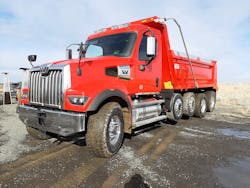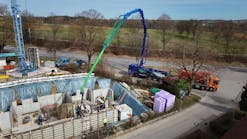For quite some time, automotive marketing people have been labeling fresh products “all-new” when they aren’t. Major parts—usually including the powertrain—are carryovers. But Western Star’s 49X severe-service heavy truck is probably as close to being all-new as any Class 8 heavy truck launched in recent years. It has a newly designed cab, hood, interior, frame, and transmission, and those things comprise quite a bit of a new vehicle. Also, its diesels are the latest versions that meet ever tighter exhaust emissions limits. Running gear, such as suspensions, wheels, tires, and brakes, are carryovers, but if you’ve spent $500 million and six years developing this truck, as company people say, I suppose you have a right to describe it any way you want.
I’d call the 49X solid, strong, comfortable, and sophisticated, and those are only some of the words that come to mind after seeing and driving several truck and tractor configurations during a press event last November at Daimler’s High Desert Proving Grounds near Madras, Oregon. I’ll zero in on a five-axle dump with a gross vehicle weight rating of 88,040 pounds that I ran through mud and rocky terrain that surrounded a working quarry. Engineering and marketing specialists accompanied me, as they did all the reporters, to guide us through the complex and keep us out of trouble. The heavy dumper performed strongly and quietly, attesting to the many design and engineering hours that went into shaping the new 49X.
Western Star 49X Cab is New
The aluminum-and-steel cab is a departure from Western Star practice. Since the mid-1990s the builder has used annealed steel in its cabs (annealing is a tougher form of galvanizing), and current cabs are still assembled from that material. The 49X’s cab and doors have aluminum skin and some structural members, while high-strength steel is used at points of high stress. Although not new to the industry (other brands have combined these materials for many years), the design combines strength with light weight and corrosion resistance. The all-steel cabs in current ’Stars are still good places to work, but the 49X’s cab is about 11 percent bigger and 8 percent lighter, and its composite roof features a “trench” in which air horns and extra lights can snuggle. The windshield is a single expanse of tinted safety glass, while an optional three-piece rear window gives a good view of what’s going on behind the cab.
The 49X’s hood is fashioned of a composite plastic material that’s stronger and a bit lighter than fiberglass. Special attention went to mounting and suspending the hood so it doesn’t shake and vibrates only slightly while the truck traverses rough ground. Our guides pointed out that movement between a hood’s rear and a cab’s cowl was miniscule, indicating the design works. Even with a downward slope that provides a decent view of what’s ahead, a 49X hood is massive when one stands in front of the handsome, vertical-bar grille. Yet it’s not difficult to pull open. Rear rubber locks are recessed into the cowl and easily pop open and snap closed. A simple lock on one of the struts keeps the wind from blowing a hood back down. There are two hood styles, one for a truck with a forward-set steer axle and another for a setback axle. This set-forward-axle dump truck steered easily with a rather small turning circle, thanks to effective steering gear and a tight wheel cut.
Western Star 49X Specifications
Under the hood was Detroit’s biggest road-legal diesel, a 15.6-liter DD16, this one rated for 560 horsepower and 1,850 lb.-ft., which should please all but the most power-hungry truckers. Not much of its sound could be heard inside the cab, making for easy conversations between occupants and soothing the nerves of a solo driver. I was surprised to see this big an engine in this kind of rig, as the dump-trucking world has pretty much gone to 12- and 13-liter diesels. But hitch a heavy pup trailer onto this dumper, especially a three- or four-axle type as used in some Plains and Northwest states, and run it up and down steep grades, and you have a good argument for big power. Western Star and its sister, Freightliner, will be happy to sell you any of five other Detroit and Cummins diesels, including the lightweight Cummins X12 that’s been shunned by most other truck builders.
Western Star 49X new features
The DT12 Vocational Extreme automated transmission worked smoothly and smartly under all conditions, and with little input from me, except when I tried out a couple of its trick capabilities. One is “rock free,” which simulates a gear-jammer’s technique of using the clutch and reverse or 1st gear to rock a truck out of a hole or while stuck in mud or deep snow. With the DT12, you toggle a switch on the control stalk and feather the accelerator to effect the same motion. The other is “pave” mode, useful when being pushed by a paver whose operator has just tooted that your bed is empty and you can move away. With an automated or automatic transmission, you have to touch the brake pedal before shifting from neutral into drive, which might irk that operator; but with this you just engage drive and move away. A guy has to know about these features to make use of them, so owners should arrange a little training and/or a driver should read the instructions to get the most out of this gearbox. As in other Western Stars, you can also spec Eaton manual and UltraShift automated transmissions as well as Allison automatics in a 49X.
One component not new was the truck’s TufTrac rear suspension, which Freightliner engineers designed quite a few years ago, though this one was Generation 2. I’ll single it out for mention because of its cushiness over a stretch of rocky and rutted ground that I took with several dumpers. I remarked on the smooth ride to my guide, and later, while driving another dump with a Hendrickson Haulmaxx EX, was shaken by the difference. The Haulmaxx is a popular and well-thought-of product, but it sent strong vibrations through the chassis and into the cab, even though cab mounts isolate the driver from much harshness. But, is the TufTrac as tough? I don’t know, but it’s sure worth a customer’s time to consider trying one if they haven’t already.
As for sophistication, the 49X comes with a host of electronic safety, diagnostic, and telematics systems, most under the Detroit Assurance name, that can make life easier for driver and owner if they take some time to learn how to use them. For instance, automatic braking can stop the truck before it rear-ends another vehicle or runs over a pedestrian. A deep pitched warning that simulates pavement rumble strips warns when the truck is about to leave a lane. Telematics, which broadcasts data to and from a fleet’s office, might not be as valuable to an individual owner-operator unless he/she captures operating numbers back home or on a personal laptop or tablet, where programs can crunch the numbers for maintenance and tax purposes. On those scores, the truck world has become a wondrous place.
Likewise for pure physical comfort built into modern trucks, including this 49X. It is a premium addition to Western Star’s vocational lineup, and is meant to enhance Daimler Trucks’ share of the vocational market, executives said during the new model’s podcast launch last fall. It does not replace the long-running, long-nose 4900, which remains available, along with the slightly shorter 4800 and compact 4700, and the off-road 6900 series. Most of those are built in Portland, Oregon, while some are assembled in Cleveland, North Carolina, which is where the 49X will be built. Should those be called Eastern Stars? I asked the podcast hosts that question, and they just chuckled. Will they be smiling at the new 49X’s sales success in, say, a year from now? If you buy one you’ll help make it so, and I predict that you’ll be happy, too.






